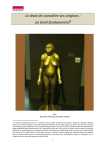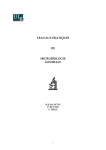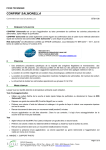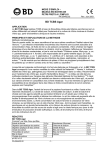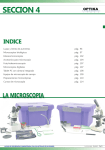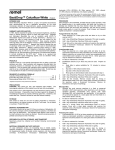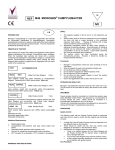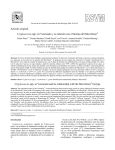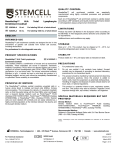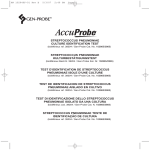Download B Difco™ Haemophilus Influenzae Antisera
Transcript
Difco™ Haemophilus B Influenzae Antisera English: pages 1 – 4 Français :pages 4 – 7 Deutsch: Seiten 7 – 10 Italiano: pagine 10 – 13 Español: páginas13 – 16 8085883(02) 2014-10 Contact your local BD representative for instructions. / Свържете се с местния представител на BD за инструкзии. / Pokyny vám poskytne místní zástupce společnosti BD. / Kontakt den lokale BD repræsentant for at få instruktioner. / Επικοινωνήστε με τον τοπικό αντιπρόσωπο της BD για οδηγίες. / Kasutusjuhiste suhtes kontakteeruge oma kohaliku BD esindajaga. / Ota yhteys lähimpään BD:n edustajaan ohjeiden saamiseksi. / Kontaktiraj lokalnog predstavnika BD za upute. / A használati utasítást kérje a BD helyi képviseletétől. / Нұсқаулар үшін жергілікті BD өкілімен хабарласыңыз. / Lai saņemtu norādījumus, sazinieties ar vietējo BD pārstāvi. / Naudojimo instrukcijų teiraukitės vietos BD įgaliotojo atstovo. / Neem contact op met uw plaatselijke BD-vertegenwoordiger voor instructies. / Kontakt din lokale BD-representant for mer informasjon. / Aby uzyskać instrukcje użytkowania, skontaktuj się z lokalnym przedstawicielstwem BD. / Contacte o representante local da BD para instruções. / Pentru instrucţiuni, contactaţi reprezentantul local BD. / Для получения указаний обратитесь к местному представителю компании BD. / Inštrukcie získate u miestneho zástupcu spoločnosti BD. / Obratite se svom lokalnom predstavniku kompanije BD za uputstva. / Kontakta närmaste BDrepresentant för anvisningar. / Talimatlar için yerel BD temsilcinizle temasa geçin. / За інструкціями зверніться до місцевого представника компанії BD. INTENDED USE Difco™ Haemophilus Influenzae Antisera are recommended for use in slide agglutination tests for serotyping Haemophilus influenzae. SUMMARY AND EXPLANATION H. influenzae constitutes part of the normal respiratory flora of humans and many animal species and can cause a variety of diseases from chronic respiratory infections to meningitis. Most of the H. influenzae isolates associated with meningitis belong to serotype b.1 H. influenzae is a nonmotile, facultative anaerobe requiring both factor X (hemin) and factor V (nicotinamide adenine dinucleotide, NAD) for in vitro growth. In microscopic morphology, the organism is a pleomorphic gram-negative coccobacillus that sometimes forms threads or filaments. The presence of a polysaccharide capsule is a major virulence factor for strains of H. influenzae that cause systemic infections. H. influenzae is divided into serologic groups a,b,c,d,e and f based on capsular polysaccharides. Most encapsulated strains that cause infection belong to serotype b.2 The encapsulated strains are referred to as “typeable strains.” Unencapsulated or “nontypeable” strains may also cause infection, but infections caused by unencapsulated strains are usually limited to the upper respiratory tract.2 Antigenic similarities exist between H. influenzae and a number of unrelated bacteria. For example, H. influenzae serotype b shares cross-reacting antigens with Streptococcus pneumoniae serotypes 6, 15a, 29 and 35a (see “LIMITATIONS OF THE PROCEDURE”). PRINCIPLES OF THE PROCEDURE Identification of H. influenzae includes the isolation of the microorganism, biochemical identification and serologic confirmation. Serologic confirmation involves the reaction in which the microorganism (antigen) reacts with its corresponding antibody. This in vitro reaction produces macroscopic clumping called agglutination. The desired homologous reaction should be rapid, tightly binding (high affinity) and not dissociate (high avidity). Because a microorganism (antigen) may agglutinate with an antibody produced in response to some other species, heterologous reactions are possible. These are characterized as forming slowly and being weak, and such unexpected and perhaps unpredictable reactions may lead to some confusion in serologic identification. A positive homologous agglutination reaction should support the morphological and biochemical identification of the microorganism. REAGENTS Difco Haemophilus Influenzae Antisera are stable, lyophilized, polyclonal rabbit antisera containing approximately 0.1% sodium azide as a preservative. When properly rehydrated and used as described (see PROCEDURE) each vial of Difco Haemophilus Influenzae Antiserum is sufficient reagent for 20 slide tests. Warnings and Precautions: For in vitro Diagnostic Use. This product contains Dry Natural Rubber. Observe aseptic technique and established precautions against microbiological hazards throughout all procedures. After use, specimens, containers, slides, tubes and other contaminated material must be sterilized by autoclaving. Directions for use should be followed carefully. WARNING: This product contains sodium azide. Sodium azide is toxic by inhalation, by skin contact, and if swallowed. Contact with acid liberates very toxic gas. After contact with skin, wash immediately with plenty of water. Sodium azide may react with lead and copper plumbing to form highly explosive metal azides. On disposal, flush with a large volume of water to prevent azide build-up. Warning H302 Harmful if swallowed. P264 Wash thoroughly after handling. P301 + P312 IF SWALLOWED: Call a POISON CENTER/doctor if you feel unwell. P501 Dispose of contents/container in accordance with local/regional/national/international regulations. Storage: Store lyophilized and rehydrated Difco™ Haemophilus Influenzae Antisera at 2–8 °C. Prolonged exposure of reagents to temperatures other than those specified is detrimental to the products. Rehydrated Difco Haemophilus Influenzae Antiserum that is cloudy or has a precipitate at any time during its period of use should be discarded. Expiration date applies to product in its intact container when stored as directed. Do not use if the product is caked, discolored or shows other signs of deterioration. SPECIMEN COLLECTION AND PREPARATION H. influenzae can be recovered from clinical specimens on chocolate agar. For specific recommendations consult appropriate references.2,3 Determine that a pure culture of the microorganism has been obtained and that biochemical test reactions are consistent with the identification of the organism as H. influenzae. After these criteria are met, serologic identification can be performed. PROCEDURE Materials Provided: Difco Haemophilus Influenzae Antiserum Poly, Difco Haemophilus Influenzae Antiserum Type a, Difco Haemophilus Influenzae Antiserum Type b, Difco Haemophilus Influenzae Antiserum Type c, Difco Haemophilus Influenzae Antiserum Type d, Difco Haemophilus Influenzae Antiserum Type e and Difco Haemophilus Influenzae Antiserum Type f. Materials Required But Not Provided: Agglutination slides, applicator sticks, sterile purified water, sterile 0.85% saline and bacteriological loops. Reagent Preparation Equilibrate all materials to room temperature prior to performing the tests. Ensure that all glassware and pipettes are clean and free of residues, such as detergent. To rehydrate Difco Haemophilus Influenzae Antisera, add 1 mL sterile purified water and rotate to completely dissolve the contents. User Quality Control At the time of use, test both positive and negative control cultures to check performance of the antisera, techniques and methodology. Quality control requirements must be performed in accordance with applicable local, state and/or federal regulations or accreditation requirements and your laboratory’s standard Quality Control procedures. It is recommended that the user refer to pertinent CLSI guidance and CLIA regulations for appropriate Quality Control practices. Test isolate for autoagglutination 1.From the test culture on chocolate agar, transfer a loopful of growth to a drop (approximately 35 µL) of sterile 0.85% saline on a clean slide and emulsify the organism. 2. Rotate the slide for 1 min, then observe for agglutination. 3.If agglutination (autoagglutination) occurs, the culture is rough and cannot be tested. Subculture to chocolate agar, incubate and test the organism again as described in steps 1 and 2. If no agglutination occurs, proceed with testing the organism as described (see Procedural Steps). Procedural Steps Culture isolates are tested with Difco Haemophilus Influenzae Antiserum Poly for presumptive identification followed by testing with monospecific antisera. 1.Put 1 drop of the Difco Haemophilus Influenzae Antiserum to be tested on an agglutination slide. 2.Transfer a loopful of growth of the test organism to the drop of antiserum and mix thoroughly. 3. Rotate the slide for 1 min and read for agglutination. RESULTS 1. Read and record results as follows: 4+ 100% agglutination (background clear to slightly hazy) 2 3+ 75% agglutination (background slightly cloudy) 2+ 50% agglutination (background moderately cloudy) 1+ 25% agglutination (background cloudy) – No agglutination 2. The positive control should produce a 3+ or greater agglutination. 3. The negative control should show no agglutination. 4.For testing isolates, a 3+ or greater agglutination within 1 min is a positive result. Positive agglutination using Difco Haemophilus Influenza Antiserum Poly and one of the individual typing sera combined with adequate biochemical results confirms the serotype of H. influenzae present. LIMITATIONS OF THE PROCEDURE 1.Correct interpretation of serologic reactions depends upon culture purity and morphological characteristics and biochemical reactions that are consistent with identification of the microorganism as H. influenzae. 2. Serologic methods alone cannot identify the isolate as H. influenzae. 3.Excessive heat from external sources (hot bacteriological loop, burner flame, light source, etc.) may prevent a smooth suspension of the microorganism or cause evaporation or precipitation of the test mixture. False-positive reactions may occur. 4.Rough culture isolates do occur and will agglutinate spontaneously causing agglutination of negative controls (autoagglutination). Smooth colonies must be selected and tested in serologic procedures. 5.H. influenzae has antigenic similarities with several unrelated bacteria. Cross-reactions can occur between H. influenzae and strains of S. pneumoniae, Escherichia coli and several species of Staphylococcus, Streptococcus and Bacillus. 6. Difco Haemophilus Influenzae Antisera have been tested using undiluted cultures taken from agar media. These antisera have not been tested using antigen suspensions in saline or other diluents. If the user applies variations in the recommended steps (see PROCEDURE), each lot of antiserum must be tested with known control cultures to verify expected reactions under the modified procedure. PERFORMANCE CHARACTERISTICS4 The performance of Difco™ Haemophilus Influenzae Antiserum Type b, manufactured by Difco Laboratories, was compared in a slide agglutination test to four other tests for serotyping isolates of Haemophilus influenzae in a study by Himmelreich, Barenkamp and Storch.4 Slide agglutination using another commmercial antiserum, coagglutination, latex agglutination and counterimmunoelectrophoresis with multiple antisera were also used to serotype isolates. Eighty (80) reference strains were used in this study. Of these isolates, 39 were Haemophilus influenzae type b.4 The table below lists the number of correctly identified isolates obtained for each test system. Difco™ Haemophilus Influenzae Antiserum Type b Slide Agglutination Test Commercial Slide Agglutination Test Commercial Latex Agglutination Test H. influenza type b 39/39 39/39 39/39 39/39 9/39 H. influenza not type b 37/37* 37/37* 37/37** 41/41 41/41 4 4 4 – – Strain Organisms not tested Commercial Counter Coagglutination ImmunoTest electrophoresis * 4 samples out of the 41 H. influenzae not type b autoagglutinated and could not be tested by the slide agglutination method. **4 samples out of the 41 H. influenzae not type b gave nonspecific reactions, agglutination of the isolate with both the H. influenzae type b and control latex preparations. AVAILABILITY Cat. No. Description 222371 BD Difco™ Haemophilus Influenzae Antiserum Poly, 1 mL 222501 BD Difco™ Haemophilus Influenzae Antiserum Type a, 1 mL 222361 BD Difco™ Haemophilus Influenzae Antiserum Type b, 1 mL 227891 BD Difco™ Haemophilus Influenzae Antiserum Type c, 1 mL 227901 BD Difco™ Haemophilus Influenzae Antiserum Type d, 1 mL 227911 BD Difco™ Haemophilus Influenzae Antiserum Type e, 1 mL 227921 BD Difco™ Haemophilus Influenzae Antiserum Type f, 1 mL REFERENCES 1.Insel, R. and P. Anderson. 1986. Haemophilus influenzae type b: assays for the capsular polysaccharide and for antipolysaccharide antibody, p. 379-384. In N.R. Rose, H. Friedman, and J.L. Fahey (ed.), Manual of clinical laboratory immunology, 3rd ed. American Society for Microbiology, Washington, D.C. 2.Campos, J.M. 1999. Haemophilus, p. 604-611. In P. R. Murray, E.J. Baron, M.A. Pfaller, F.C. Tenover, and R.H. Yolken (ed.), Manual of clinical microbiology, 7th ed. American Society for Microbiology, Washington, D.C. 3 3.Pezzlo, M. 1992. Aerobic bacteriology, p.1.0.1-1.20.47. In H.D. Isenberg (ed.), Clinical microbiology procedures handbook, vol.1. American Society for Microbiology, Washington, D.C. 4.Himmelreich, C.A., S.J. Barenkamp and G.A. Storch. 1985. Comparison of methods for serotyping of Haemophilus influenzae. J. Clin. Microbiol. 21: 158-160. Technical Information: In the United States contact BD Technical Service and Support at 800-638-8663 or www.bd.com/ds. Haemophilus BDifco Influenzae Antisera Français APPLICATION Les Difco Haemophilus Influenzae Antisera (sérums anti-Haemophilus influenzae Difco) sont recommandés pour réaliser des tests d’agglutination sur lame utilisés pour le sérotypage d’Haemophilus influenzae. RESUME ET EXPLICATION H. influenzae fait partie de la flore bactérienne respiratoire normale chez l’homme et d’autres espèces animales et peut provoquer diverses maladies allant des infections respiratoires chroniques à la méningite. La plupart des isolats d’H. influenzae associés à la méningite appartiennent au sérotype b.1 H. influenzae est un anaérobie facultatif non motile. Sa culture in vitro nécessite du facteur X (hémine) et du facteur V (nicotinamide adénine dinucléotide, NAD). Sur le plan morphologique, le microorganisme est un coccobacille Gram négatif polymorphe parfois filamenteux. La présence d’une capsule polysaccharidique est l’un des principaux facteurs de virulence des souches d’H. influenzae responsables d’infections systémiques. H. influenzae se répartit en six groupes sérologiques a, b, c, d, e et f en fonction des polysaccharides capsulaires. La plupart des souches encapsulées pouvant provoquer une infection appartiennent au sérotype b.2 Les souches encapsulées sont appelées « souches typables ». Les souches non encapsulées ou « souches non typables » peuvent également s’avérer infectieuses, mais les infections provoquées par les souches non encapsulées se limitent habituellement aux voies respiratoires supérieures.2 Il existe des similarités antigéniques entre H. influenzae et un certain nombre de bactéries non apparentées. Par exemple, le sérotype b d’H. influenzae possède des antigènes qui présentent une réaction croisée avec les sérotypes 6, 15a, 29 et 35a de Streptococcus pneumoniae (voir « limites de la procédure »). PRINCIPES DE LA METHODE L’identification d’H. influenzae comprend l’isolement du microorganisme, son identification biochimique et sa confirmation sérologique. La confirmation sérologique implique une réaction dans laquelle un antigène du microorganisme réagit avec l’anticorps correspondant. Cette réaction in vitro entraîne une formation d’agrégats macroscopiques appelée agglutination. La réaction homologue souhaitée doit être rapide et créer une liaison forte (affinité élevée) présentant une réversibilité faible (avidité élevée). Comme l’antigène du microorganisme peut agglutiner un anticorps produit en réponse à une infection par d’autres espèces bactériennes, des réactions hétéro logues sont possibles. Ces réactions se caractérisent par une vitesse lente et une affinité faible. De telles réactions inattendues voire imprévisibles peuvent entacher d’incertitude l’identification sérologique. Une réaction d’agglutination homologue positive doit concorder avec l’identification du microorganisme sur la base de ses caractéristiques biochimiques et morphologiques. REACTIFS Les Difco Haemophilus Influenzae Antisera sont des antisérums de lapin polyclonaux stables, lyophilisés, contenant environ 0,1 % d’azide de sodium comme agent conservateur. Convenablement réhydraté et utilisé conformément aux instructions (voir méthode), un flacon de Difco Haemophilus Influenzae Antiserum permet de réaliser 20 tests sur lame. Avertissement et précautions : Réservé au diagnostic in vitro. Ce produit contient du caoutchouc naturel sec. Toujours utiliser une technique aseptique et prendre les précautions habituelles contre les dangers microbiologiques pendant les procédures. Après utilisation, stériliser les échantillons à l’autoclave, les récipients, les lames, les tubes et les autres matériels contaminés. Respecter scrupuleusement le mode d’emploi. 4 AVERTISSEMENT : Ce produit contient de l’azide de sodium, qui est toxique par inhalation, contact avec la peau ou ingestion. Au contact d’un acide, un gaz très toxique est dégagé. Après tout contact avec la peau, laver immédiatement à grande eau. L’azide de sodium peut réagir au contact du plomb ou du cuivre des canalisations et former des azides métalliques très explosifs. Lors de l’élimination, faire couler un volume d’eau important pour éviter l’accumulation d’azides. Attention H302 Nocif en cas d’ingestion. P264 Se laver soigneusement après manipulation. P301 + P312 EN CAS D’INGESTION: Appeler un CENTRE ANTIPOISON ou un médecin en cas de malaise. P501 Éliminer le contenu/récipient conformément aux règlements locaux/régionaux/nationaux/internationaux. Conservation : Conserver les Difco Haemophilus Influenzae Antisera lyophilisés et reconstitués entre 2 et 8 °C. L’exposition prolongée des réactifs à des températures autres que les températures spécifiées a un effet adverse sur ceux-ci. Eliminer le Difco Haemophilus Influenzae Antiserum réhydraté s’il est trouble ou présente un précipité, même temporairement, en cours d’utilisation. La date de péremption s’applique au produit contenu dans son emballage intact et conservé conformément aux instructions. Ne pas utiliser si le produit présente un aspect agglutiné, décoloré ou d’autres signes de détérioration. PRELEVEMENT ET PREPARATION DES ECHANTILLONS H. influenzae peut être isolé à partir d’échantillons cliniques mis en culture sur gélose au chocolat. Pour obtenir des recommandations spécifiques, consulter les références appropriées.2,3 Etablir qu’une culture pure de microorganismes a été obtenue et que les résultats des tests biochimiques concordent avec l’identification du microorganisme comme H. influenzae. Si ces conditions sont remplies, l’identification sérologique peut être effectuée. METHODE Matériaux fournis : Difco Haemophilus Influenzae Antiserum Poly, Difco Haemophilus Influenzae Antiserum Type a, Difco Haemophilus Influenzae Antiserum Type b, Difco Haemophilus Influenzae Antiserum Type c, Difco Haemophilus Influenzae Antiserum Type d, Difco Haemophilus Influenzae Antiserum Type e et Difco Haemophilus Influenzae Antiserum Type f. Matériaux requis mais non fournis: Lames à agglutination, écouvillons, eau purifiée stérile, solution saline stérile à 0,85 %, anse bactériologique. Préparation du réactif Laisser tous les matériels s’équilibrer à température ambiante avant de procéder aux tests. S’assurer que la verrerie et les pipettes utilisées sont propres et exemptes de résidus (traces de détergent par exemple). Pour reconstituer les Difco Haemophilus Influenzae Antisera, ajouter 1 mL d’eau purifiée stérile et agiter doucement avec un mouvement de rotation pour dissoudre le contenu. Contrôle de qualité par l’utilisateur Tester dans la même série des contrôles positifs et négatifs pour contrôler les performances des antisérums, des techniques et de la méthodologie. Effectuer les contrôles de qualité conformément aux réglementations locales, nationales et/ou internationales en vigueur, aux exigences des organismes d’homologation concernés et aux procédures de contrôle de qualité en vigueur dans l’établissement. Il est recommandé à l’utilisateur de consulter les directives CLSI et la réglementation CLIA correspondantes pour plus d’informations sur les modalités de contrôle de qualité. Test d’autoagglutination de l’isolat 1.A l’aide d’un ensemenceur, prélever une pleine anse de culture bactérienne à analyser sur la boîte de gélose au chocolat, transférer le contenu dans une goutte (environ 35 µL) de solution saline stérile à 0,85 % déposée sur une lame propre et mettre en suspension les microorganismes. 2.Agiter pendant 1 min par un mouvement de rotation de la lame, puis observer s’il se produit une réaction d’agglutination. 3.Si une agglutination se produit (autoagglutination), la culture n’est pas pure et ne peut pas être testée. Répliquer sur gélose au chocolat, incuber et tester de nouveau le microorganisme comme expliqué aux étapes 1 et 2. Si aucune agglutination n’est observée, poursuivre le test du microorganisme exposé ci-dessous (voir Etapes de la méthode). 5 Etapes de la méthode On procède tout d’abord à une identification présomptive des isolats de culture avec Difco Haemophilus Influenzae Antiserum Poly, puis à des tests avec les antisérums monospécifiques. 1.Déposer 1 goutte du Difco Haemophilus Influenzae Antiserum à tester sur une lame à agglutination. 2.A l’aide d’un ensemenceur, transférer une pleine anse de culture bactérienne à analyser dans la goutte d’antisérum et bien mélanger. 3.Agiter pendant 1 min par un mouvement de rotation de la lame, puis observer s’il se produit une réaction d’agglutination. RESULTATS 1. Lire et reporter les résultats comme suit : 4+ 100 % d’agglutination (fond clair à légèrement voilé) 3+ 75 % d’agglutination (fond légèrement trouble) 2+ 50 % d’agglutination (fond moyennement trouble) 1+ 25 % d’agglutination (fond trouble) – Absence d’agglutination. 2.Le témoin positif doit provoquer une agglutination de niveau 3+ ou supérieur. 3. Le témoin négatif ne doit présenter aucune agglutination. 4.S’agissant des isolats à tester, une agglutination de niveau 3+ ou supérieur en moins de 1 min constitue un résultat positif. Un résultat d’agglutination positif avec le Difco Haemophilus Influenza Antiserum Poly et l’un des sérums de typage individuel, associé à des tests biochimiques concordants, confirme la présence du sérotype d’H. influenzae. LIMITES DE LA PROCEDURE 1.La pertinence de l’interprétation des réactions sérologiques est fonction de la pureté de la culture et de la concordance des réactions biochimiques et des caractéristiques morphologiques identifiant le microorganisme comme H. influenzae. 2.Utilisées seules, les méthodes sérologiques ne suffisent pas à identifier un isolat comme étant H. influenzae. 3.Une source de chaleur externe excessive (anse d’ensemenceur brûlante, flamme du bec bunsen, source lumineuse, etc.) peut empêcher d’obtenir une suspension fluide du microorganisme ou entraîner une évaporation ou la précipitation du mélange réactionnel. Des faux positifs risquent d’être obtenus. 4.Des isolats de culture non purs sont parfois obtenus et provoquent une agglutination spontanée entraînant l’agglutination des témoins négatifs (autoagglutination). Choisir des colonies lisses et les tester suivant les méthodes sérologiques. 5.H. influenzae présente des similarités antigéniques avec un certain nombre de bactéries non apparentées. Des réactions croisées peuvent se produire entre H. influenzae et certaines souches de S. pneumonia ou Escherichia coli, ainsi que plusieurs espèces de Staphylocoques, de Streptocoques et de Bacilles. 6. Les Difco Haemophilus Influenzae Antisera ont été testés sur des cultures non diluées prélevées sur milieu gélosé. Ces antisérums n’ont pas été testés sur des suspensions d’antigène réalisées dans du sérum physiologique ou d’autres diluants. Si l’utilisateur apporte des variations aux étapes recommandées (voir METHODE), chaque lot d’antisérum doit être testé en utilisant des cultures témoins connues pour s’assurer que la méthode modifiée permet d’obtenir les résultats escomptés. CARACTERISTIQUES DE PERFORMANCES4 Les performances du Difco Haemophilus Influenzae Antiserum Type b, fabriqué par les laboratoires Difco, ont été comparées, par test d’agglutination sur lame, à quatre autres tests pour stérotyper les isolats de Haemophilus influenzae dans une étude menée par Himmelreich, Barenkamp et Storch.4 Une agglutination sur lame utilisant un autre antisérum commercialisé, un test d’agglutination de groupe, une agglutination au latex et une contre-immuno-électrophorèse avec plusieurs antisérums, a aussi été effectuée pour sérotyper les isolats. Quatre-vingt (80) souches de référence ont été utilisées dans cette étude. Parmi ces isolats, 39 étaient des Haemophilus influenzae de type b.4 6 Le tableau ci-dessous liste le nombre d’isolats correctement identifiés obtenus pour chaque système de test. Test d’agglutination sur lame Difco Haemophilus Influenzae Antiserum Type b Test d’agglutination sur lame commercialisé Test d’agglu tination au latex commercialisé H. influenza type b 39/39 39/39 39/39 39/39 9/39 H. influenza non type b 37/37* 37/37* 37/37** 41/41 41/41 4 4 4 – – Souche Microorganismes non testés Test d’aggluContretination immunode groupe électrophorèse commercialisé * 4 échantillons d’H. influenzae sur les 41 non type b ont produit une autoagglutination et n’ont pas pu être testés par la méthode de l’agglutination sur lame. **4 échantillons d’H. influenzae sur les 41 non type b ont produit des réactions non spécifiques, une agglutination de l’isolat avec à la fois les préparations d’H. influenzae de type b et les témoins au latex. CONDITIONNEMENT No réf. Description 222371 BD Difco Haemophilus Influenzae Antiserum Poly, 1 mL 222501 BD Difco Haemophilus Influenzae Antiserum Type a, 1 mL 222361 BD Difco Haemophilus Influenzae Antiserum Type b, 1 mL 227891 BD Difco Haemophilus Influenzae Antiserum Type c, 1 mL 227901 BD Difco Haemophilus Influenzae Antiserum Type d, 1 mL 227911 BD Difco Haemophilus Influenzae Antiserum Type e, 1 mL 227921 BD Difco Haemophilus Influenzae Antiserum Type f, 1 mL BIBIOGRAPHIE : voir la section “References” dans la notice en anglais. Service et assistance technique de BD Diagnostics : contacter votre représentant local de BD. Haemophilus BDifco Influenzae Antisera Deutsch VERWENDUNGSZWECK Es wird empfohlen, Difco Haemophilus Influenzae Antisera für ObjektträgerAgglutinationstests zur Serotypisierung von Haemophilus influenzae zu verwenden. ZUSAMMENFASSUNG UND ERKLÄRUNG H. influenzae ist ein Bestandteil der normalen Bakterienflora des Atemsystems des Menschen sowie vieler Tierarten und kann eine Reihe von Erkrankungen verursachen – von chronischen Atemwegsinfekten bis hin zu Meningitis. Die meisten mit Meningitis assoziierten H. influenzae-Isolate zählen zum Serotyp B.1 H. influenzae ist ein unbeweglicher, fakultativ anaerober Organismus, der für sein Wachstum in vitro sowohl Faktor X (Hämin) als auch Faktor V (Nicotinamid-adenindinucleotid, NAD) benötigt. In mikroskopisch-morphologischer Hinsicht handelt es sich um einen pleomorphen, gramnegativen Kokkenbazillus, der mitunter Stränge oder Fäden bildet. Das Vorliegen einer Polysaccharid-Kapsel ist ein wichtiger Faktor für die Virulenz der systemische Infektionen verursachenden H. influenzae-Stämme. H. influenzae wird auf der Grundlage der Kapsel-Polysaccharide in die serologischen Gruppen A, B, C, D, E und F eingeteilt. Die meisten der Infektionen verursachenden bekapselten Stämme zählen zum Serotyp B.2 Die bekapselten Stämme werden als „typisierbare Stämme“ bezeichnet. Unbekapselte oder „nicht typisierbare“ Stämme können ebenfalls Infektionen verursachen, jedoch sind die durch unbekapselte Stämme verursachten Infektionen gewöhnlich auf die oberen Atemwege beschränkt.2 H. influenzae hat in antigener Hinsicht Ähnlichkeit mit einer Reihe nicht verwandter Bakterien. So teilt bspw. H. influenzae des Serotyps B kreuzreagierende Antigene mit den Streptococcus pneumoniae-Serotypen 6, 15a, 29 und 35a (siehe „VERFAHRENSBESCHRÄNKUNGEN“). VERFAHRENSGRUNDLAGEN Die Identifizierung von H. influenzae umfasst die Isolierung des Mikroorganismus, die biochemische Identifizierung und die serologische Bestätigung. Zur serologischen Bestätigung zählt die Reaktion, in welcher der Mikroorganismus (Antigen) mit dem entsprechenden Antikörper reagiert. Bei dieser In-vitro-Reaktion kommt es zu makroskopischen Verklumpungen, der sogenannten Agglutination. Die gewünschte homologe Reaktion sollte rasch, mit fester Bindung (hoher Affinität) und ohne Dissoziation (hohe Avidität) erfolgen. Da ein Mikroorganismus (Antigen) auch mit Antikörpern agglutinieren kann, die als Reaktion auf andere Spezies gebildet wurden, sind heterologe Reaktionen möglich. Diese zeichnen sich durch einen langsamen und schwachen Reaktionsverlauf 7 aus, und derartige unerwartete und evtl. unvorhersehbare Reaktionen können bei der serologischen Identifizierung einige Verwirrung stiften. Eine positive homologe Agglutinationsreaktion sollte die morphologische und biochemische Identifizierung des Mikroorganismus unterstützen. REAGENZIEN Difco Haemophilus Influenzae Antisera sind stabile, lyophilisierte, polyklonale Kaninchen-Antiseren, die ca. 0,1 % Natriumazid als Konservierungsmittel enthalten. Bei korrekter Rehydration und vorschriftsmäßiger Anwendung (siehe VERFAHREN) enthält jedes Fläschchen Difco Haemophilus Influenzae Antiserum eine ausreichende Reagenzienmenge für 20 Objektträger-Tests. Warnungen und Vorsichtsmaßnahmen: In-vitro-Diagnostikum. Dieses Produkt enthält Naturkautschuk (getrocknet). Der Umgang mit mikrobiologischem Material sollte bei allen Verfahren unter Einhaltung aseptischer Kautelen und der allgemein üblichen Vorsichtsmaßnah men erfolgen. Nach Gebrauch sind Proben, Behälter, Objektträger, Röhrchen und sonstiges kontaminiertes Material im Autoklaven zu sterilisieren. Die Gebrauchsanleitung ist sorgfältig zu befolgen. WARNUNG: Dieses Produkt enthält Natriumazid, das beim Einatmen, bei Berührung mit der Haut und beim Verschlucken sehr giftig ist. Bei Kontakt mit Säure entstehen hochgiftige Gase. Bei Kontakt mit der Haut sofort mit viel Wasser abwaschen. Natriumazid kann mit Blei- und Kupferleitungen reagieren und hochexplosive Metallazide bilden. Beim Entsorgen mit sehr viel Wasser nachspülen, um Ansammlungen von Azid zu vermeiden. Achtung H302 Gesundheitsschädlich bei Verschlucken. P264 Nach Gebrauch gründlich waschen. P301 + P312 BEI VERSCHLUCKEN: Bei Unwohlsein GIFTINFORMATIONSZENTRUM oder Arzt anrufen. P501 Inhalt/Behälter gemäß den örtlichen/regionalen/nationalen/internationalen Bestimmungen entsorgen. Aufbewahrung: Lyophilisiertes und rehydriertes Difco Haemophilus Influenzae Antisera bei 2 bis 8 °C aufbewahren. Werden die Reagenzien längere Zeit anderen Temperaturen ausgesetzt als vorgeschrieben, ist dies den Produkten abträglich. Erscheint rehydriertes Difco Haemophilus Influenzae Antiserum zu irgendeinem Zeitpunkt während seiner Verwendung wolkig oder weist Ausfällungen auf, ist es zu verwerfen. Das Verfallsdatum gilt für das im unversehrten Behälter aufbewahrte Produkt bei Einhaltung der Lagervorschriften. Zusammenklebendes, verfärbtes oder sonstige Verfallsanzeichen aufweisendes Produkt nicht verwenden. PROBENENTNAHME UND -VORBEREITUNG H. influenzae kann aus klinischen Proben auf Schokoladen-Agar gewonnen werden. Bezüglich spezifischer Empfehlungen in einschlägigen Quellen nachschlagen.2,3 Sicherstellen, dass eine Reinkultur des Mikroorganismus gewonnen wurde und die biochemischen Testreaktionen der Identifizierung des Organismus als H. influenzae entsprechen. Wenn diese Kriterien erfüllt sind, kann die serologische Identifizierung durchgeführt werden. VERFAHREN Mitgeliefertes Arbeitsmaterial: Difco Haemophilus Influenzae Antiserum Poly, Difco Haemophilus Influenzae Antiserum Type a, Difco Haemophilus Influenzae Antiserum Type b, Difco Haemophilus Influenzae Antiserum Type c, Difco Haemophilus Influenzae Antiserum Type d, Difco Haemophilus Influenzae Antiserum Type e and Difco Haemophilus Influenzae Antiserum Type f. Benötigtes, jedoch nicht mitgeliefertes Arbeitsmaterial: AgglutinationsObjektträger, Applikatorstäbchen, steriles, destilliertes Wasser, sterile 0,85%ige Kochsalzlösung und bakteriologische Ösen. Vorbereitung der Reagenzien Vor der Testdurchführung alle Materialien auf Zimmertemperatur äquilibrieren lassen. Sicherstellen, dass alle gläsernen Utensilien und Pipetten sauber sind und keine Rückstände aufweisen (wie bspw. von Reinigungsmitteln). Zum Rehydrieren des Difco Haemophilus Influenzae Antisera 1 mL steriles, destilliertes Wasser zugeben und so lange drehen, bis der Inhalt vollständig gelöst ist. Qualitätssicherung durch den Anwender Bei Anwendung sowohl positive als auch negative Kontrollen durchführen, um die Leistung der Antiseren, die Techniken und die Methodik zu überprüfen. 8 Die Qualitätskontrollen müssen unter Einhaltung der örtlich, landesweit und/oder bundesweit geltenden Bestimmungen oder Auflagen der Akkreditierungsorganisationen sowie der Standard-Qualitätskontrollverfahren Ihres Labors erfolgen. Anwendern wird geraten, die relevanten CLSI-Richtlinien und CLIA-Vorschriften über geeignete Maßnahmen zur Qualitätskontrolle einzusehen. Testen des Isolats im Hinblick auf Autoagglutination 1.Eine Impföse voll Wachstum von der Testkultur auf Schokoladen-Agar zu einem Tropfen (ca. 35 µL) steriler 0,85%iger Kochsalzlösung auf einen sauberen Objektträger transferieren und den Organismus emulgieren. 2.Den Objektträger 1 min lang drehen und anschließend im Hinblick auf Agglutination begutachten. 3.Falls es zu einer Agglutination (Autoagglutination) kommt, ist die Kultur grob und nicht zum Test geeignet. Eine Subkultur auf Schokoladen-Agar anlegen, inkubieren und den Organismus erneut testen, wie in den Schritten 1 und 2 beschrieben. Kommt es nicht zu einer Agglutination, mit dem Testen des Organismus wie beschrieben fortfahren (siehe Verfahrensschritte). Verfahrensschritte Kulturisolate werden zur präsumtiven Identifizierung mit Difco Haemophilus Influenzae Antiserum Poly getestet und anschließend mit monospezifischen Antiseren. 1.Einen Tropfen des zu testenden Difco Haemophilus Influenzae Antiserum auf einen Agglutinations-Objektträger geben. 2.Eine Öse voll Testorganismus-Wachstum zu dem Tropfen Antiserum transferieren und gut mischen. 3.Den Objektträger 1 min lang drehen und anschließend im Hinblick auf Agglutination begutachten. ERGEBNISSE 1. Die Ergebnisse werden folgendermaßen abgelesen und dokumentiert: 4+ 100%ige Agglutination (Hintergrund klar bis leicht trüb) 3+ 75%ige Agglutination (Hintergrund leicht wolkig) 2+ 50%ige Agglutination (Hintergrund mäßig wolkig) 1+ 25%ige Agglutination (Hintergrund wolkig) – Keine Agglutination 2.Die positive Kontrolle sollte eine Agglutination des Grades 3+ oder stärker ergeben. 3. Die negative Kontrolle darf keine Agglutination aufweisen. 4.Beim Testen von Isolaten stellt eine innerhalb 1 Min erfolgende Agglutination des Grades 3+ oder stärker ein positives Ergebnis dar. Eine positive Agglutination bei Verwendung von Difco Haemophilus Influenza Antiserum Poly und einem der individuellen Typisierungsseren in Verbindung mit adäquaten biochemischen Resultaten bestätigt das Vorliegen des H. influenzae-Serotyps. VERFAHRENSBESCHRÄNKUNGEN 1.Eine korrekte Interpretation der serologischen Reaktionen ist abhängig von der Reinheit der Kultur, den morphologischen Eigenschaften und biochemischen Reaktionen, die der Identifizierung des Mikroorganismus als H. influenzae entsprechen. 2.Serologische Methoden allein sind nicht ausreichend zur Identifizierung des Isolats als H. influenzae. 3.Übermäßige Wärme aus externen Quellen (heiße bakteriologische Öse, Brennerflamme, Lichtquelle u. dgl.) kann die glatte Suspension des Mikro organismus verhindern oder zum Verdunsten oder Ausfällen des Testgemischs führen. Es kann zu falsch positiven Reaktionen kommen. 4.Grobe Kulturisolate sind möglich; sie agglutinieren spontan und führen zur Agglutination negativer Kontrollen (Autoagglutination). Es sind glatte Kolonien zu wählen und mit serologischen Verfahren zu testen. 5.H. Influenzae hat in antigener Hinsicht Ähnlichkeit mit einer Reihe nicht verwandter Bakterien. Kreuzreaktionen können zwischen H. influenzae und Stämmen von S. pneumoniae, Escherichia coli und mehreren Staphylococcus-, Streptococcusund Bacillus-Spezies auftreten. 6.Die Difco Haemophilus Influenzae Antisera wurden unter Verwendung unverdünnter Kulturen aus Agar-Medien getestet. Diese Antiseren wurden nicht mit Antigen-Suspensionen in Kochsalzlösung oder sonstigen Verdünnungsmitteln getestet. Weicht der Anwender von den empfohlenen Schritten (siehe VERFAHREN) ab, ist jede Charge des Antiserums mit bekannten Kontrollkulturen zu testen, um die erwarteten Reaktionen bei dem modifizierten Verfahren zu bestätigen. LEISTUNGSMERKMALE4 Die Leistung von Difco Haemophilus Influenzae Antiserum Type b, hergestellt von Difco Laboratories, wurde in einer Studie von Himmelreich, Barenkamp und Storch in einem Objektträger-Agglutinatinstest mit vier anderen Tests für SerotypIsolate verglichen.4 Objekträger-Agglutination mit einem anderen handelsüblichen Antiserum, Koagglutination. Latex-Agglutination und Counter-Immunelektrophorese mit mehreren Antiseren wurden ebenfalls auf die Serotyp-Isolate angewendet. In 9 dieser Studie wurden achtzig (80) Referenzstämme verwendet. Von diesen Isolaten entsprachen 39 Haemophilus influenzae, Typ B.4 Die nachstehende Tabelle führt die Anzahl der korrekt identifizierten Isolate für jedes Testsystem auf. Stamm Difco Haemophilus Influenzae Antiserum Type b; ObjektträgerAgglutinationstest Handelsüblicher Handelsüblicher Handelsüblicher CounterObjektträgerLatexKoagglutinImmunAgglutinAgglutinationstes elektrophorese ationstest ationstest H. influenza type b 39/39 39/39 39/39 39/39 9/39 H. influenza non type b 37/37* 37/37* 37/37** 41/41 41/41 4 4 4 – – Nicht getestete Organismen * 4 Proben aus den 41 H. influenzae entsprechen nicht dem autoagglutinierten Typ B und konnten nicht mit der Objektträger-Agglutinationsmethode getestet werden. **4 Proben aus den 41 H. influenzae entsprechen nicht dem Typ B und lieferten nichtspezifische Reaktionen; Agglutination des Isolats mit sowohl H. influenzae Typ B als auch Kontrolle-Latexvorbereitungen. LIEFERBARE PRODUKTE Best.- Nr. 222371 222501 222361 227891 227901 227911 227921 Beschreibung BD Difco Haemophilus Influenzae Antiserum Poly, 1 mL BD Difco Haemophilus Influenzae Antiserum Type a, 1 mL BD Difco Haemophilus Influenzae Antiserum Type b, 1 mL BD Difco Haemophilus Influenzae Antiserum Type c, 1 mL BD Difco Haemophilus Influenzae Antiserum Type d, 1 mL BD Difco Haemophilus Influenzae Antiserum Type e, 1 mL BD Difco Haemophilus Influenzae Antiserum Type f, 1 mL LITERATURNACHWEIS: S. “Reference” im englischen Text. BD Diagnostics Technischer Kundendienst: setzen Sie sich mit Ihrer zuständigen BD-Vertretung. Haemophilus BDifco Influenzae Antisera Italiano USO PREVISTO Gli antisieri Difco Haemophilus Influenzae Antisera sono indicati nei test di agglutinazione su vetrino per la sierotipizzazione di Haemophilus influenzae. SOMMARIO E SPIEGAZIONE H. influenzae fa parte della normale flora respiratoria e di molte specie animali e può causare varie malattie, dalle infezioni respiratorie croniche alla meningite. La maggior parte degli isolati di H. influenzae associati alla meningite appartiene al sierotipo b.1 H. influenzae è un organismo anaerobio facoltativo non mobile che richiede, per la crescita in vitro, sia il fattore X (emina) che il fattore V (nicotinammide adenina dinucleotide, NAD). Secondo la morfologia microscopica, l’organismo è un coccobacillo pleomorfico gram-negativo che talvolta si dispone a filamenti. La presenza di una capsula polisaccaridica conferisce una maggiore virulenza ai ceppi di H. influenzae che causano infezioni sistemiche. H. influenzae è diviso in gruppi sierologici a,b,c,d,e,f in base ai polisaccaridi della capsula. La maggior parte dei ceppi capsulati che causano infezioni appartiene al sierotipo b.2 I ceppi capsulati vengono chiamati “ceppi caratterizzabili”. Anche i ceppi non capsulati o “non caratterizzabili” possono causare infezioni che interessano generalmente le vie respiratorie superiori.2 Esistono analogie antigeniche tra H. influenzae e numerosi batteri distinti. Ad esempio, H. influenzae sierotipo b condivide reazioni crociate con i sierotipi 6, 15a, 29 e 35a di Streptococcus pneumoniae (vedere “LIMITI DELLA PROCEDURA”). PRINCIPI DELLA PROCEDURA Il riconoscimento di H. influenzae include l’isolamento del microrganismo, l’identificazione biochimica e la conferma sierologica. La conferma sierologica include la reazione in cui il microrganismo (antigene) reagisce con l’anticorpo corrispondente. Questa reazione in vitro produce grumi macroscopici, un fenomeno chiamato agglutinazione. La reazione desiderata tra gli omologhi deve essere rapida, strettamente legante (alta affinità) e non dissociata (avidità elevata). Esiste la possibilità di reazioni tra eterologhi, in quanto un microrganismo (antigene) può agglutinare un anticorpo prodotto in risposta ad alcune altre specie. Queste reazioni sono deboli e caratterizzate da formazione lenta; sono inoltre inaspettate e imprevedibili e possono causare una certa confusione nell’identificazione 10 sierologica. Una reazione di agglutinazione positiva tra omologhi deve essere coerente con l’identificazione morfologica e biochimica del microrganismo. REAGENTI Difco Haemophilus Influenzae Antisera sono antisieri policlonali di coniglio, stabili e liofilizzati, contenenti circa 0,1% di sodio azide come conservante. Ciascun flacone di Difco Haemophilus Influenzae Antiserum, se correttamente reidratato e usato come descritto (vedere PROCEDURA), contiene reagente sufficiente per 20 test su vetrino. Avvertenze e precauzioni: Per uso diagnostico in vitro. Questo prodotto contiene gomma naturale secca. Durante tutte le procedure, attenersi ad una tecnica asettica e rispettare le misure precauzionali stabilite contro i rischi microbiologici. Dopo l’uso, sterilizzare in autoclave campioni, contenitori, vetrini, provette e tutti gli altri materiali contaminati. Seguire attentamente le istruzioni per l’uso. AVVERTENZA: Questo prodotto contiene sodio azide, tossica per inalazione, ingestione e a contatto con la pelle. A contatto con acido, libera gas estremamente tossici. In caso di contatto con la pelle, lavarsi immediatamente e abbondantemente con acqua. La sodio azide può reagire con il piombo e il rame delle tubature, formando azidi metalliche altamente esplosive. Eliminare la sodio azide facendo scorrere abbondante acqua negli scarichi per impedire l’accumulo di azidi. Attenzione H302 Nocivo se ingerito. P264 Lavarsi accuratamente dopo l’uso. P301 + P312 IN CASO DI INGESTIONE: In caso di malessere, contattare un CENTRO ANTIVELENI o un medico. P501 Smaltire il prodotto/recipiente in conformità alle normative locali/ regionali/nazionali/internazionali. Conservazione: Conservare gli antisieri Difco Haemophilus Influenzae Antisera liofilizzati e reidratati a 2 – 8 °C. L’esposizione prolungata dei reagenti a temperature diverse da quelle indicate può danneggiare i prodotti. Scartare l’antisiero Difco Haemophilus Influenzae Antiserum se evidenzia torbidità o precipitato in qualsiasi momento durante l’uso. La data di scadenza si riferisce al prodotto nel contenitore intatto e conservato come prescritto. Non usare il prodotto se appare indurito, scolorito o presenta altri segni di deterioramento. RACCOLTA E PREPARAZIONE DEI CAMPIONI H. influenzae può essere recuperato da campioni clinici su agar cioccolato. Per specifiche informazioni, consultare la documentazione appropriata.2,3 Stabilire che la coltura del microrganismo sia pura e che le reazioni biochimiche siano coerenti con l’identificazione dell’organismo come H. influenzae. Una volta soddisfatti questi criteri, è possibile eseguire l’identificazione sierologica. PROCEDURA Materiali forniti: Difco Haemophilus Influenzae Antiserum Poly, Difco Haemophilus Influenzae Antiserum Tipo a, Difco Haemophilus Influenzae Antiserum Tipo b, Difco Haemophilus Influenzae Antiserum Tipo c, Difco Haemophilus Influenzae Antiserum Tipo d, Difco Haemophilus Influenzae Antiserum Tipo e Difco Haemophilus Influenzae Antiserum Tipo f. Materiali necessari ma non forniti: Vetrini per agglutinazione, applicatori a bastoncino, acqua purificata sterile, soluzione fisiologica sterile allo 0,85% e anse batteriologiche. Preparazione dei reagenti Prima di eseguire le analisi, lasciare equilibrare tutti i materiali a temperatura ambiente. Assicurarsi che tutta la vetreria e le pipette siano pulite e prive di residui di detergente o altro. Per reidratare Difco Haemophilus Influenzae Antisera, aggiungere 1 mL di acqua purificata e sterile e roteare per dissolvere completamente il contenuto. Controllo di qualità a cura dell’utente Al momento dell’uso, testare le colture di controllo positiva e negativa per verificare le performance degli antisieri, le tecniche e la metodologia. Le procedure prescritte per il controllo di qualità devono essere effettuate in conformità alle norme vigenti o ai requisiti di accreditazione e alla prassi di controllo di qualità del laboratorio specifico. Consultare le linee guida CLSI e le norme CLIA in materia, per una corretta esecuzione delle procedure relative al controllo di qualità. 11 Test di agglutinazione dell’isolato 1.Dalla coltura su agar cioccolato, prelevare un’ansata di crescita e trasferirla su una goccia (circa 35 µL), trasferirla su una goccia di soluzione fisiologica sterile allo 0,85% su un vetrino pulito ed emulsificare l’organismo. 2. Roteare il vetrino per 1 min e poi osservare l’agglutinazione. 3.Se si verifica agglutinazione (autoagglutinazione), la coltura è disomogenea e non può essere analizzata. Eseguire una subcoltura su agar cioccolato, incubare e testare di nuovo l’organismo come descritto nei passaggi 1 e 2. Se non si verifica agglutinazione, procedere con l’analisi dell’organismo come descritto (vedere Passaggi della procedura). Passaggi della procedura Gli isolati da coltura vengono analizzati con Difco Haemophilus Influenzae Antiserum Poly per una identificazione presuntiva seguita da test con antisieri monospecifici. 1.Dispensare su un vetrino di agglutinazione 1 goccia di Difco Haemophilus Influenzae Antiserum da analizzare. 2.Prelevare un’ansata di crescita dell’organismo da testare, trasferirla sulla goccia di antisiero e mescolare accuratamente. 3. Roteare il vetrino per 1 min e poi leggere il risultato di agglutinazione. RISULTATI 1. Leggere e registrare i risultati come segue. 4+100% di agglutinazione (sfondo da trasparente a leggermente appannato) 3+ 75% di agglutinazione (sfondo leggermente torbido) 2+ 50% di agglutinazione (sfondo moderatamente torbido) 1+ 25% di agglutinazione (sfondo torbido) – Nessuna agglutinazione 2.Il controllo positivo deve fornire un risultato di agglutinazione pari a 3+ o superiore. 3. Il controllo negativo non deve evidenziare alcuna agglutinazione. 4.Per il test degli isolati, si considera positivo un risultato di agglutinazione pari a 3+ o superiore entro 1 min. La presenza del sierotipo di H. influenzae viene confermata dall’agglutinazione positiva ottenuta utilizzando Difco Haemophilus Influenza Antiserum Poly e uno dei sieri per tipizzazione individuale in combinazione con risultati biochimici adeguati. LIMITAZIONI DELLA PROCEDURA 1.La corretta interpretazione delle reazioni sierologiche dipende dalla purezza della coltura e dall’osservazione di caratteristiche morfologiche e reazioni bio chimiche coerenti con l’identificazione del microrganismo come H. influenzae. 2.I soli metodi sierologici non sono in grado di identificare l’isolato come H. influenzae. 3.Il calore eccessivo da fonti esterne (ansa batteriologica calda, fiamma di bruciatore, sorgente di illuminazione, ecc.) può impedire la sospensione omogenea del microrganismo o causare evaporazione o precipitazione della miscela da analizzare e dar luogo a reazioni falsamente positive. 4.Le colture disomogenee di isolati sono soggette ad agglutinazione spontanea con conseguente agglutinazione dei controlli negativi (autoagglutinazione). Per le procedure sierologiche è necessario selezionare ed analizzare colonie omogenee. 5.H. influenzae presenta analogie antigeniche con vari batteri distinti. È possibile che si verifichino reazioni crociate tra H. influenzae e ceppi di S. pneumoniae, Escherichia coli oltre a varie specie di Staphylococcus, Streptococcus e Bacillus. 6. Gli antisieri Difco Haemophilus Influenzae Antisera sono stati analizzati utilizzando colture non diluite prelevate da terreni agar. Questi antisieri non sono stati testati con sospensioni di antigeni in soluzione fisiologica o in altri diluenti. Se l’operatore introduce delle variazioni nei passaggi raccomandati per la procedura (vedere PROCEDURA), ciascun lotto di antisiero deve essere testato con colture di controllo per verificare le reazioni previste in base alla procedura modificata. PRESTAZIONI METODOLOGICHE4 Le prestazioni metodologiche di Difco Haemophilus Influenzae Antiserum Tipo b, prodotto da Difco Laboratories, sono state confrontate durante un test di agglutinazione su vetrino con altri quattro test per la sierotipizzazione degli isolati di Haemophilus influenzae in uno studio condotto da Himmelreich, Barenkamp e Storch.4 Per la sierotipizzazione degli isolati sono stati inoltre utilizzati altri metodi, come l’agglutinazione su vetrino con un diverso antisiero in commercio, la coagglutinazione, l’agglutinazione al latex e la controimmunoelettroforesi con antisieri multipli. In questo studio, sono state impiegate ottanta (80) ceppi di riferimento. Di questi isolati, 39 erano di Haemophilus influenzae tipo b.4 12 La tabella seguente elenca il numero degli isolati identificati correttamente da ciascun sistema di test. Ceppo Difco Haemophilus Influenzae Antiserum Tipo b Test di agglutinazione su vetrino Test di Test di agglutinazione su vetrino in commercio Test di agglutinazione al latex in commercio Test di coaggluti nazione in commercio Test Contro immunoelettroforesi H. influenza tipo b 39/39 39/39 39/39 39/39 9/39 H. influenza non tipo b 37/37* 37/37* 37/37** 41/41 41/41 4 4 4 – – Organismi non testati * 4 campioni tra i 41di H. influenzae non di tipo b si sono autoagglutinati e non è stato possibile analizzarli con il metodo di agglutinazione su vetrino. **4 campioni tra i 41 di H. influenzae non di tipo b hanno prodotto reazioni non specifiche, agglutinazione dell’isolato sia conH. influenzae tipo b che con le preparazioni di controllo al latex. DISPONIBILITÀ N. di cat. Descrizione 222371 BD Difco Haemophilus Influenzae Antiserum Poly, 1 mL 222501 BD Difco Haemophilus Influenzae Antiserum Tipo a, 1 mL 222361 BD Difco Haemophilus Influenzae Antiserum Tipo b, 1 mL 227891 BD Difco Haemophilus Influenzae Antiserum Tipo c, 1 mL 227901 BD Difco Haemophilus Influenzae Antiserum Tipo d, 1 mL 227911 BD Difco Haemophilus Influenzae Antiserum Tipo e, 1 mL 227921 BD Difco Haemophilus Influenzae Antiserum Tipo f, 1 mL BIBLIOGRAFIA: Vedr “References” en el texto en inglés. Assistenza e supporto tecnico BD Diagnostics: rivolgersi al rappresentante locale BD. Haemophilus BDifco Influenzae Antisera Español USO PREVISTO Difco Haemophilus Influenzae Antisera (antisueros Difco para Haemophilus Influenzae) se recomiendan para uso en pruebas de aglutinación en portaobjetos para determinar los serotipos de Haemophilus influenzae. RESUMEN Y EXPLICACIÓN H. influenzae forma parte de la flora respiratoria normal de los seres humanos y de muchas especies animales, y puede causar una variedad de enfermedades, desde infecciones respiratorias crónicas hasta meningitis. La mayoría de las cepas aisladas de H. influenzae asociadas con la meningitis pertenecen al serotipo b.1 H. influenzae es un anaerobio facultativo inmóvil que requiere tanto el factor X (hemina) como el factor V (dinucleótido de nicotinamida adenina, NAD) para el crecimiento in vitro. En la morfología microscópica, el organismo es un bacilococo pleomórfico gramnegativo que a veces forma hilos o filamentos. La presencia de una cápsula de polisacárido es un factor de virulencia importante para cepas de H. influenzae que causan infecciones sistémicas. H. influenzae se divide en los grupos serológicos a, b, c, d, e y f, según los polisacáridos capsulares. La mayoría de las cepas encapsuladas que causan infecciones pertenecen al serotipo b.2 Las cepas encapsuladas se conocen como “cepas tipificables”. Las cepas no encapsuladas o “no tipificables” también pueden causar infecciones, pero éstas por lo general se circunscriben a las vías respiratorias superiores.2 Existen similitudes antigénicas entre H. influenzae y un número de bacterias no relacionadas. Por ejemplo, el serotipo b de H. influenzae comparte antígenos que producen reacciones cruzadas con los serotipos 6, 15a, 29 y 35a de Streptococcus pneumoniae (véase “LIMITACIONES DEL PROCEDIMIENTO”). PRINCIPIOS DEL PROCEDIMIENTO La identificación de H. influenzae incluye el aislamiento del microorganismo, la identificación bioquímica y la confirmación serológica. La confirmación serológica se produce mediante la reacción en la que el microorganismo (antígeno) reacciona con el anticuerpo correspondiente. Esta reacción in vitro produce la formación de grumos macroscópicos denominada aglutinación. La reacción homóloga deseada debe ser rápida, de unión fuerte (alta afinidad) y no disociativa (alta avidez). Dado que un microorganismo (antígeno) puede aglutinarse con un anticuerpo producido como respuesta a alguna otra especie, son posibles las reacciones heterólogas. Éstas se caracterizan por una formación lenta y por su debilidad, y tales reacciones inesperadas y quizás impredecibles podrían ocasionar algo de confusión en cuanto a la identificación serológica. Una reacción de aglutinación 13 homóloga positiva debería apoyar la identificación morfológica y bioquímica del microorganismo. REACTIVOS Difco Haemophilus Influenzae Antisera son antisueros de conejo policlonales, estables y liofilizados que contienen aproximadamente 0,1% de azida sódica como conservante. Cuando se rehidrata correctamente y se utiliza según lo descrito (véase PROCEDI MIENTO), cada frasco de Difco Haemophilus Influenzae Antiserum proporciona una cantidad suficiente de reactivo para realizar 20 pruebas en portaobjetos. Advertencias y precauciones: Para uso diagnóstico in vitro. Este producto contiene goma natural seca. Emplear una técnica aséptica y seguir las precauciones habituales contra peligros microbiológicos durante todos los procedimientos. Después del uso, se deberán esterilizar muestras, envases, portaobjetos, tubos y demás material contaminado en autoclave. Es necesario seguir al pie de la letra las instrucciones de uso. ADVERTENCIA: Este producto contiene azida sódica, la cual es tóxica en caso de inhalación, contacto con la piel e ingestión. El contacto con ácidos libera un gas muy tóxico. En caso de contacto con la piel, lavar de inmediato el área afectada con abundante agua. La azida sódica puede reaccionar con las cañerías de plomo y cobre y formar azidas metálicas muy explosivas. Al eliminar el material por el desagüe, utilizar un gran volumen de agua para evitar la acumulación de azidas. Atención H302 Nocivo en caso de ingestión. P264 Lavarse concienzudamente tras la manipulación. P301 + P312 EN CASO DE INGESTIÓN: Llamar a un CENTRO DE INFORMACION TOXICOLOGICA o a un médico en caso de malestar. P501 Eliminar el contenido/el recipiente de conformidad con las normativas locales, regionales, nacionales e internacionales. Almacenamiento: Conservar los Difco Haemophilus Influenzae Antisera, liofilizados y rehidratados, a una temperatura de 2 – 8 °C. Una exposición prolongada de los reactivos a temperaturas diferentes de las especificadas es perjudicial para los productos. Se deberá desechar todo antisuero Difco Haemophilus Influenzae Antiserum rehidratado que tenga un aspecto turbio o que contenga precipitado en cualquier momento durante su período de uso. La fecha de caducidad se aplica al producto conservado en su envase intacto de la forma indicada. No utilizar si el producto está aglutinado o descolorido, o si evidencia otras señales de deterioro. RECOGIDA Y PREPARACIÓN DE LAS MUESTRAS Es posible recuperar H. influenzae a partir de muestras clínicas en agar chocolate. Consultar las referencias correspondientes para obtener recomendaciones específicas.2,3 Determinar que se ha obtenido un cultivo puro del microorganismo y que las reacciones de las pruebas bioquímicas sean coherentes con la identificación del organismo como H. influenzae. Después de haberse satisfecho estos criterios, se podrá realizar la identificación serológica. PROCEDIMIENTO Materiales suministrados: Difco Haemophilus Influenzae Antiserum Poly, Difco Haemophilus Influenzae Antiserum Type a, Difco Haemophilus Influenzae Antiserum Type b, Difco Haemophilus Influenzae Antiserum Type c, Difco Haemophilus Influenzae Antiserum Type d, Difco Haemophilus Influenzae Antiserum Type e y Difco Haemophilus Influenzae Antiserum Type f. Materiales necesarios pero no suministrados: Portaobjetos de aglutina ción, aplicadores, agua purificada estéril, solución salina al 0,85% estéril y asas bacteriológicas. Preparación del reactivo Equilibrar todos los materiales a temperatura ambiente antes de realizar las pruebas. Asegurarse de que el material de vidrio y las pipetas estén limpios y libres de residuos, como, por ejemplo, detergente. Para rehidratar Difco Haemophilus Influenzae Antisera, añadir 1 mL de agua purificada estéril y girar para disolver el contenido completamente. Control de calidad del usuario En el momento de uso, analizar los cultivos de control tanto positivos como negativos para comprobar el rendimiento de los antisueros, las técnicas y la metodología. El control de calidad se debe llevar a cabo conforme a la normativa local y/o nacional, a los requisitos de los organismos de acreditación y a los procedimientos estándar de control de calidad del laboratorio. Se recomienda consultar las 14 instrucciones pertinentes del CLSI y la normativa de la CLIA para obtener información acerca de las prácticas adecuadas de control de calidad. Análisis de la cepa aislada para determinar la autoaglutinación 1.A partir de un cultivo de prueba en agar chocolate, transferir un asa llena de crecimiento a una gota (aproximadamente 35 µL) de solución salina al 0,85% estéril en un portaobjetos limpio, y emulsionar el organismo. 2.Girar el portaobjetos durante 1 min y luego observar para determinar si se ha producido aglutinación. 3.Si ocurre la aglutinación (autoaglutinación), el cultivo es rugoso y no se podrá analizar. Realizar un subcultivo en agar chocolate, incubarlo y volver a analizar el organismo tal como se describe en los pasos 1 y 2. Si no ocurre ningún tipo de aglutinación, realizar el análisis del organismo tal como se describe (véase Pasos del procedimiento). Pasos del procedimiento Las cepas aisladas en cultivos se prueban con Difco Haemophilus Influenzae Antiserum Poly para realizar la identificación presuntiva seguida de las pruebas con antisueros monoespecíficos. 1.Colocar 1 gota del Difco Haemophilus Influenzae Antiserum a ser analizado en un portaobjetos de aglutinación. 2.Transferir un asa llena de crecimiento del organismo de prueba a la gota de antisuero y mezclar bien. 3.Girar el portaobjeto durante 1 min y efectuar la lectura para determinar si se ha producido aglutinación. RESULTADOS 1. Leer y registrar los resultados de la siguiente forma: 4+ 100% de aglutinación (fondo transparente a ligeramente lechoso) 3+ 75% de aglutinación (fondo ligeramente turbio) 2+ 50% de aglutinación (fondo moderadamente turbio) 1+ 25% de aglutinación (fondo turbio) – Sin aglutinación 2. El control positivo debe producir una aglutinación de 3+ o mayor. 3. El control negativo no debe mostrar ningún indicio de aglutinación. 4.Para las cepas aisladas del análisis, un valor de aglutinación de 3+ o más al cabo de 1 min indica un resultado positivo. La aglutinación positiva usando Difco Haemophilus Influenzae Antiserum Poly y uno de los sueros individuales para determinar el tipo combinado con los resultados bioquímicos correspondientes confirma el serotipo del H. influenzae presente. LIMITACIONES DEL PROCEDIMIENTO 1.La interpretación correcta de las reacciones serológicas depende de la pureza del cultivo, de sus características morfológicas y de las reacciones bioquímicas acordes con la identificación del microorganismo como H. influenzae. 2.Los métodos serológicos por sí solos no pueden identificar la cepa aislada como H. influenzae. 3.El calor excesivo proveniente de fuentes externas (asa bacteriológica caliente, llama del mechero, fuente de luz, etc.) podría impedir una suspensión uniforme del microorganismo o causar la evaporación o precipitación de la mezcla de análisis. Pueden ocurrir reacciones positivas falsas. 4.Efectivamente ocurren cepas aisladas de cultivos rugosos, las cuales se aglutinarán espontáneamente, causando la aglutinación de los controles negativos (autoaglutinación). Es necesario seleccionar y analizar colonias uniformes en los procedimientos serológicos. 5.H. Influenzae tiene similitudes antigénicas con varias bacterias no rela cionadas. Pueden ocurrir reacciones cruzadas entre H. influenzae y cepas de S. pneumoniae, Escherichia coli, y varias especies de Staphylococcus, Streptococcus y Bacillus. 6.Se han analizado Difco Haemophilus Influenzae Antisera usando cultivos sin diluir tomados a partir de medios de agar. Estos antisueros no han sido analizados usando suspensiones de antígenos en solución salina o en otros diluyentes. Si el usuario aplica variaciones en los pasos recomendados (véase PROCEDIMIENTO), cada lote de antisuero se deberá analizar con cultivos de control conocidos para verificar las reacciones esperadas según el procedimiento modificado. CARACTERÍSTICAS DE RENDIMIENTO4 El rendimiento de Difco Haemophilus Influenzae Antiserum Type b, fabricado por Difco Laboratories, fue comparado en una prueba de aglutinación en portaobjetos a otras cuatro pruebas para la determinación de serotipos de Haemophilus influenzae en un estudio realizado por Himmelreich, Barenkamp y Storch.4 Para determinar el serotipo de los aislados, también se utilizó aglu tinación en portaobjetos por medio de otro antisuero comercial, coagluti nación, aglutinación de látex y contrainmunoelectroforesis con antisueros múltiples. En este estudio se utilizaron 80 cepas de referencia. De dichos aislados, 39 se determinaron como Haemophilus influenzae tipo b.4 15 En la tabla siguiente se indica el número de aislados correctamente identificados obtenidos en cada sistema de prueba. Cepa Difco Haemophilus Influenzae Antiserum Type b, prueba de aglutinación en portaobjetos Prueba comercial de aglutinación en portaobjetos Prueba comercial de aglutilnación de látex Prueba comercial de coaglutinación de látex Contrainmunoelectroforesis H. influenza tipo b 39/39 39/39 39/39 39/39 9/39 H. influenza no tipo b 37/37* 37/37* 37/37** 41/41 41/41 4 4 4 – – Organismos no analizados * 4 muestras de un total de 41 de H. influenzae no tipo b generaron autoaglutinación y no pudieron analizarse por medio del método de aglutinación en portaobjetos. **4 muestras de un total de 41 de H. influenzae no tipo b presentaron reacciones no específicas, aglutinación del aislado con ambas preparaciones de H. influenzae tipo b y de látex de control. DISPONIBILIDAD Nº ref. Descripción 222371 BD Difco Haemophilus Influenzae Antiserum Poly, 1 mL 222501 BD Difco Haemophilus Influenzae Antiserum Type a, 1 mL 222361 BD Difco Haemophilus Influenzae Antiserum Type b, 1 mL 227891 BD Difco Haemophilus Influenzae Antiserum Type c, 1 mL 227901 BD Difco Haemophilus Influenzae Antiserum Type d, 1 mL 227911 BD Difco Haemophilus Influenzae Antiserum Type e, 1 mL 227921 BD Difco Haemophilus Influenzae Antiserum Type f, 1 mL BIBLIOGRAFIA: Vedr “References” en el texto en inglés. Servicio técnico de BD Diagnostics: póngase en contacto con el representante local de BD. 16 Manufacturer / Производител / Výrobce / Fabrikant / Hersteller / Κατασκευαστής / Fabricante / Tootja / Fabricant / Proizvođać / Gyártó / Fabbricante / Атқарушы / Gamintojas / Ražotājs / Tilvirker / Producent / Producător / Производитель / Výrobca / Proizvođač / Tillverkare / Üretici / Виробник Use by / Използвайте до / Spotřebujte do / Brug før / Verwendbar bis / Χρήση έως / Usar antes de / Kasutada enne / Date de péremption / Upotrijebiti do / Felhasználhatóság dátuma / Usare entro / Дейін пайдалануға / Naudokite iki / Izlietot līdz / Houdbaar tot / Brukes for / Stosować do / Prazo de validade / A se utiliza până la / Использовать до / Použite do / Upotrebiti do / Använd före / Son kullanma tarihi / Використати до\line YYYY-MM-DD / YYYY-MM (MM = end of month) ГГГГ-ММ-ДД / ГГГГ-ММ (ММ = края на месеца) RRRR-MM-DD / RRRR-MM (MM = konec měsíce) ÅÅÅÅ-MM-DD / ÅÅÅÅ-MM (MM = slutning af måned) JJJJ-MM-TT / JJJJ-MM (MM = Monatsende) ΕΕΕΕ-MM-HH / ΕΕΕΕ-MM (MM = τέλος του μήνα) AAAA-MM-DD / AAAA-MM (MM = fin del mes) AAAA-KK-PP / AAAA-KK (KK = kuu lõpp) AAAA-MM-JJ / AAAA-MM (MM = fin du mois) GGGG-MM-DD / GGGG-MM (MM = kraj mjeseca) ÉÉÉÉ-HH-NN / ÉÉÉÉ-HH (HH = hónap utolsó napja) AAAA-MM-GG / AAAA-MM (MM = fine mese) ЖЖЖЖ-АА-КК / ЖЖЖЖ-АА / (АА = айдың соңы) MMMM-MM-DD / MMMM-MM (MM = mėnesio pabaiga) GGGG-MM-DD/GGGG-MM (MM = mēneša beigas) JJJJ-MM-DD / JJJJ-MM (MM = einde maand) ÅÅÅÅ-MM-DD / ÅÅÅÅ-MM (MM = slutten av måneden) RRRR-MM-DD / RRRR-MM (MM = koniec miesiąca) AAAA-MM-DD / AAAA-MM (MM = fim do mês) AAAA-LL-ZZ / AAAA-LL (LL = sfârşitul lunii) ГГГГ-ММ-ДД / ГГГГ-ММ (ММ = конец месяца) RRRR-MM-DD / RRRR-MM (MM = koniec mesiaca) GGGG-MM-DD / GGGG-MM (MM = kraj meseca) ÅÅÅÅ-MM-DD / ÅÅÅÅ-MM (MM = slutet av månaden) YYYY-AA-GG / YYYY-AA (AA = ayın sonu) РРРР-MM-ДД / РРРР-MM (MM = кінець місяця) Catalog number / Каталожен номер / Katalogové číslo / Katalognummer / Αριθμός καταλόγου / Número de catálogo / Katalooginumber / Numéro catalogue / Kataloški broj / Katalógusszám / Numero di catalogo / Каталог нөмірі / Katalogo numeris / Kataloga numurs / Catalogus nummer / Numer katalogowy / Număr de catalog / Номер по каталогу / Katalógové číslo / Kataloški broj / Katalog numarası / Номер за каталогом Authorized Representative in the European Community / Оторизиран представител в Европейската общност / Autorizovaný zástupce pro Evropském společenství / Autoriseret repræsentant i De Europæiske Fællesskaber / Autorisierter Vertreter in der Europäischen Gemeinschaft / Εξουσιοδοτημένος αντιπρόσωπος στην Ευρωπαϊκή Κοινότητα / Representante autorizado en la Comunidad Europea / Volitatud esindaja Euroopa Nõukogus / Représentant autorisé pour la Communauté européenne / Autorizuirani predstavnik u Europskoj uniji / Meghatalmazott képviselő az Európai Közösségben / Rappresentante autorizzato nella Comunità Europea / Европа қауымдастығындағы уәкілетті өкіл / Įgaliotasis atstovas Europos Bendrijoje / Pilnvarotais pārstāvis Eiropas Kopienā / Bevoegde vertegenwoordiger in de Europese Gemeenschap / Autorisert representant i EU / Autoryzowane przedstawicielstwo we Wspólnocie Europejskiej / Representante autorizado na Comunidade Europeia / Reprezentantul autorizat pentru Comunitatea Europeană / Уполномоченный представитель в Европейском сообществе / Autorizovaný zástupca v Európskom spoločenstve / Autorizovano predstavništvo u Evropskoj uniji / Auktoriserad representant i Europeiska gemenskapen / Avrupa Topluluğu Yetkili Temsilcisi / Уповноважений представник у країнах ЄС In Vitro Diagnostic Medical Device / Медицински уред за диагностика ин витро / Lékařské zařízení určené pro diagnostiku in vitro / In vitro diagnostisk medicinsk anordning / Medizinisches In-vitro-Diagnostikum / In vitro διαγνωστική ιατρική συσκευή / Dispositivo médico para diagnóstico in vitro / In vitro diagnostika meditsiiniaparatuur / Dispositif médical de diagnostic in vitro / Medicinska pomagala za In Vitro Dijagnostiku / In vitro diagnosztikai orvosi eszköz / Dispositivo medicale per diagnostica in vitro / Жасанды жағдайда жүргізетін медициналық диагностика аспабы / In vitro diagnostikos prietaisas / Medicīnas ierīces, ko lieto in vitro diagnostikā / Medisch hulpmiddel voor in-vitro diagnostiek / In vitro diagnostisk medisinsk utstyr / Urządzenie medyczne do diagnostyki in vitro / Dispositivo médico para diagnóstico in vitro / Dispozitiv medical pentru diagnostic in vitro / Медицинский прибор для диагностики in vitro / Medicínska pomôcka na diagnostiku in vitro / Medicinski uređaj za in vitro dijagnostiku / Medicinteknisk produkt för in vitro-diagnostik / İn Vitro Diyagnostik Tıbbi Cihaz / Медичний пристрій для діагностики in vitro 17 Temperature limitation / Температурни ограничения / Teplotní omezení / Temperaturbegrænsning / Temperaturbegrenzung / Περιορισμοί θερμοκρασίας / Limitación de temperatura / Temperatuuri piirang / Limites de température / Dozvoljena temperatura / Hőmérsékleti határ / Limiti di temperatura / Температураны шектеу / Laikymo temperatūra / Temperatūras ierobežojumi / Temperatuurlimiet / Temperaturbegrensning / Ograniczenie temperatury / Limites de temperatura / Limite de temperatură / Ограничение температуры / Ohraničenie teploty / Ograničenje temperature / Temperaturgräns / Sıcaklık sınırlaması / Обмеження температури Batch Code (Lot) / Код на партидата / Kód (číslo) šarže / Batch-kode (lot) / Batch-Code (Charge) / Κωδικός παρτίδας (παρτίδα) / Código de lote (lote) / Partii kood / Numéro de lot / Lot (kod) / Tétel száma (Lot) / Codice batch (lotto) / Топтама коды / Partijos numeris (LOT) / Partijas kods (laidiens) / Lot nummer / Batch-kode (parti) / Kod partii (seria) / Código do lote / Cod de serie (Lot) / Код партии (лот) / Kód série (šarža) / Kod serije / Partinummer (Lot) / Parti Kodu (Lot) / Код партії Consult Instructions for Use / Направете справка в инструкциите за употреба / Prostudujte pokyny k použití / Se brugsanvisningen / Gebrauchsanweisung beachten / Συμβουλευτείτε τις οδηγίες χρήσης / Consultar las instrucciones de uso / Lugeda kasutusjuhendit / Consulter la notice d’emploi / Koristi upute za upotrebu / Olvassa el a használati utasítást / Consultare le istruzioni per l’uso / Пайдалану нұсқаулығымен танысып алыңыз / Skaitykite naudojimo instrukcijas / Skatīt lietošanas pamācību / Raadpleeg de gebruiksaanwijzing / Se i bruksanvisningen / Zobacz instrukcja użytkowania / Consultar as instruções de utilização / Consultaţi instrucţiunile de utilizare / См. руководство по эксплуатации / Pozri Pokyny na používanie / Pogledajte uputstvo za upotrebu / Se bruksanvisningen / Kullanım Talimatları’na başvurun / Див. інструкції з використання Dickinson and Company m7Becton, Loveton Circle Sparks, MD 21152 USA ABenex Limited Pottery Road, Dun Laoghaire Co. Dublin, Ireland Difco is a trademark of Difco Laboratories, Inc., a subsidiary of Becton, Dickinson and Company. BD and BD Logo are trademarks of Becton, Dickinson and Company. © 2014 BD.


















